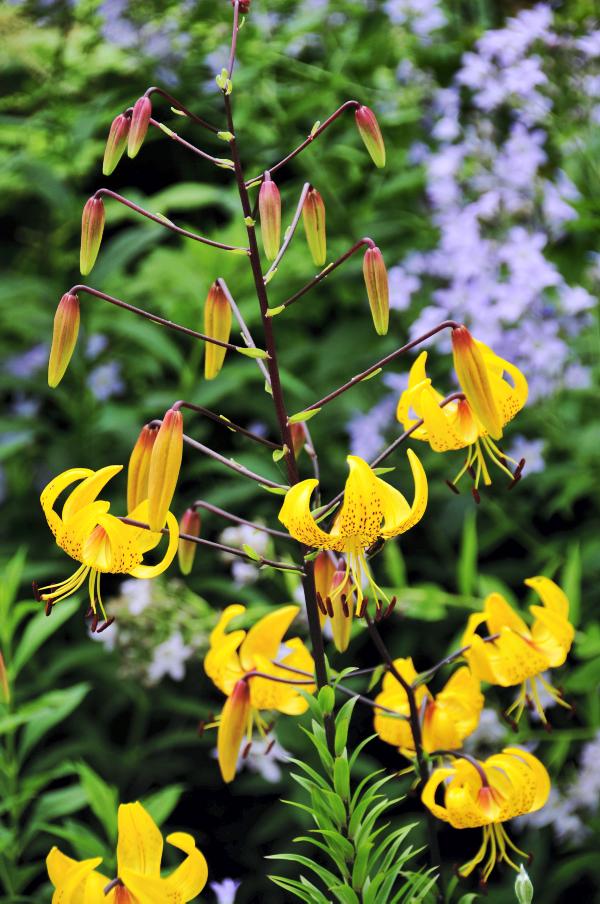The flowers of lilies are a byword for beauty, elegance and style, and that is not surprising, because few flowers have anything like the same potent mixture of shapeliness, colour and captivating perfume. It is easy to use this beauty and style to transform a summer garden. Just as spring bulbs transform the garden in spring, lilies can do it in summer.
The big difference is that a few lily flowers can have a powerful effect on the look of a garden, or part of a garden in which they are located.
The shape of the lily flowers varies between the species, but these are really just variations on a theme. The flower heads are made up of large, single flowers, as much as 15cm across, with a trumpet shape formed from six petals – often thick and waxen.
The mouths of the flowers of most lilies flare open, even turn back or reflex over themselves, and this flaring of the flower trumpets lends a lively shape, almost a joyous celebration of their flowering.
Decades ago in cottage gardens, the white madonna lily and the tiger lily were popular, usually in shades of red, hot orange or bright yellow. Bulbs were passed on by friends and neighbours. The madonna lily can tolerate years of neglect.
Indeed, it does best when it is planted in very well-drained soil in full sunshine. It carries up to 20 trumpet-shaped flowers, pure wax white in colour and sweetly scented. The tiger lily appears to be completely pest and disease resistant, although the red lily beetle, which has now arrived in the country, can affect it.
The tiger lily has been used in breeding programmes for its disease resistance.
There are lots of lily hybrids, including the Asiatic group of very reliable hybrids like the orange Enchantment lily, the ivory-white Sterling Silver, the red Fire King, and the bright yellow Connecticut King.
These are hardy and easy to grow, needing very little care and attention, flowering relatively early in July. They flower without fail and last for years. All of these have short stems and upward-facing flowers.
The size of the flowerhead, like in most lilies, depends on how rich the soil is. In really rich ground, football-sized flowerheads can be produced.
The regal lily is another beauty and a great favourite, with long, flaring trumpets that are flushed with wine-purple on the outside and thick petals with a yellow flash in the throat.
It can reach up to two metres when well-grown, though it is usually about half that height. The flowers are beautifully scented, a true sweet lily fragrance that wafts a long way from the plant on a summer evening.
The turkscap lily, or martagon lily, is relatively easy to grow with masses of small reflexed, purple flowers, turban-like. It is a mountain meadow plant and does well in our cool, moist climate and in partial shade. Lilies like well-drained soil, enriched with humus, free-draining and not wet in winter.
In areas with heavy soil, coarse sand or gravel can be mixed into the planting space to open up the soil and raise a small mound.
Lilies can be bought in flower in pots and placed in the garden for instant effects, or bulbs can be planted in autumn or spring.
Remove dierama seed heads
The wandflower or angel’s fishing rod, or using its botanical name of dierama, is a much-admired garden flower, widely grown, but it can also become a tricky weed when conditions suit it. It is from rough mountain grassland in South Africa and very competitive. It sends up slender arching leaves, which eventually wither and fall to make a mantle of withered foliage that smothers small, competing plants.
It produces lots of viable seeds and it is easily grown from seed, so easily that practically any garden that has dierama also has its grassy seedlings. It has a knack of getting seedlings right into the middle of neighbouring plants and taking over their space. If you do not want seedlings, cut off the flowers when the petals have fallen.
Flowers
Weeds in flower borders should be hoed or hand-weeded and not allowed to go to seed. Bedding plants in pots and baskets need regular watering and feeding. Seedlings of perennial flowers, such as lupins, mallows and foxgloves, can be pricked out into small pots, or lined out in a fine seed bed.
Trees, shrubs & roses
Continue to monitor young trees and shrubs for water shortage. Many trees are lost in the first year when a couple of heavy waterings would have saved them. Early flowering shrub roses and ramblers that have now finished could be pruned by removing some of the shoots that flowered.
Fruit, vegetables and herbs
Spring cabbage can be sown now for supplies in April and May. Do not let weeds go to seed to avoid building up trouble for the years to come. It is usually not necessary to spray apple trees for apple scab at this stage and many trees seem to be on a rest year after producing a heavy crop last year.
Lawn
Keep lawn edges neat around beds and borders as they have a tendency to grow out now. If a lawn is not growing well, and not just because of low rainfall, which is common on light soil, it should be fed with some lawn fertilizer or nitrogen fertilizer, but only if the soil is moist and rain is on the way.
Greenhouse and house plants
Take cuttings of flowering shrubs now – many kinds are easy to raise and can be used to fill gaps. Also take cuttings of geraniums and fuchsias for next year. Grapes will be reaching full size soon. Continue watering and feeding greenhouse plants. Be especially careful to water plants in pots.






 This is a subscriber-only article
This is a subscriber-only article











SHARING OPTIONS: